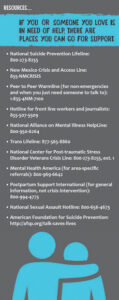Experts fear pandemic could lead to increase in suicide
 New Mexico continues to have one of the highest rates of suicide in the country, and experts worry the COVID-19 pandemic could cause the state’s suicide rate to increase in 2021.
New Mexico continues to have one of the highest rates of suicide in the country, and experts worry the COVID-19 pandemic could cause the state’s suicide rate to increase in 2021.
In 2019, New Mexico lost 515 people to suicide, according to research by the Legislative Finance Committee released this month. And while preliminary data showed no statistical increase in suicides from January through October of 2020, the state has seen an increase in calls to its crisis phone line. The LFC also projects a 20 percent increase in behavioral health needs next year.
Suicide does not have one cause, according to Matthew Probst, medical director for El Centro Family Health. But he said some form of trauma is typically involved whenever someone attempts to kill themselves.
“That’s what it comes down to. Depression comes from a root of educational disparity, economic disparity, substance misuse in the house, violence (or) sexual abuse,” Probst said. “All of those things are the common roots of addiction, suicide, all kinds of stuff.”
Adults over the age of 24 accounted for the most suicides in the state, according to the LFC report, but suicide accounted for 29 percent of deaths for those between the ages of 15 to 24. In fact, since 2014, New Mexico has been one of the top 15 states for teen suicides.
Late this year, San Miguel County lost two young boys to suicide, according to Probst. It’s the sort of thing he and El Centro have worked to prevent through Semillas de Salud, which provides training to area youth to empower them to provide peer health education to others. But Probst said that because kids aren’t in school during the pandemic, it’s a lot harder for peers or teachers to spot warning signs of deep depression.
Addiction and suicide are part of what Probst called the “disease and despairer wolf pack,” and he called COVID-19 the new alpha wolf.
“It’s the new alpha, but all it did was make these other diseases stronger,” he said. “And with the COVID wolf in there, and people locked up (at home), the rates of those other things are also on the increase. It was always hard to identify before, but now what do you do? We don’t even know where a lot of kids in the state are.”
The model of El Centro’s school-based health center is greatly affected by remote learning, Probst said. It’s more difficult for teachers or a student’s classmates to recognize signs of despair during video calls, and Probst said that regular home visits by the Children, Youth and Families Department have largely been eliminated too, reducing one more way for someone to spot warning signs.
“Everybody is experiencing a sense of loss, and those normal contact points. Maybe you’re not getting what you need at home, but a teacher identifies that. Your peers identify that. Your coaches identify that,” Probst said. “Going back to these two boys, they weren’t actively seeking care, and they weren’t necessarily on anybody’s radar.”
Suicide is not limited to those still attending school though. Adults age 25 to 34 are the highest risk category, according to data from the New Mexico Department of Health. In New Mexico throughout 2019, 75 people within this age group took their own life, and through late November 2020, 74 within this age group had committed suicide.
Early in November, New Mexico’s journalism community was rocked by the death of 29-year-old Hannah Colton, a reporter and news director at KUNM-FM in Albuquerque. Colton’s soothing voice could be heard in Las Vegas on 91.9 FM as she delivered the day’s news, as well as deep dives into important social justice issues. In Colton’s obituary, her family wrote that she was “a victim of depression and the isolation of the pandemic.”
According to the Kaiser Family Foundation, 45 percent of American adults said the pandemic had negatively affected their mental health. For that reason, mental health professionals stress the importance of recognizing the signs that someone is considering suicide.
For kids, teens and those up to age 24, the American Association of Suicidology advises to get help for someone if they are talking about wanting to die, if they are talking about suicide or if they are cutting or burning themselves.
The warning signs in adults are similar, including making threats of hurting or killing themselves, looking for ways to kill themselves by seeking access to firearms or pills, or talking or writing about death, dying or suicide. The AAS also warns to watch for increased use of alcohol or drugs, anxiety or agitation, withdrawal from friends or someone who is giving away prized possessions.
The pandemic has added tremendous pressure to health care workers and first responders as well. In response, the State of New Mexico recently launched a support line specifically for those on the front lines of the state’s pandemic response. It connects them to a professional counselor 24 hours a day. In the wake of Colton’s death, the state has also made the helpline available to journalists.
Probst said that along with increased isolation, the coronavirus pandemic has forced people to stop participating in things they enjoy, things like youth sports and holiday events. He said when something like that isn’t available, it’s natural for humans to feel a sense of loss, which can lead to depression.
“If you lose something you care a lot about, it’s a real sense of loss. Don’t downplay that,” Probst said. “Instead, we need to support people. Really support them. Let them know we are here for them. That whole message is therapy, and it’s so important.”



